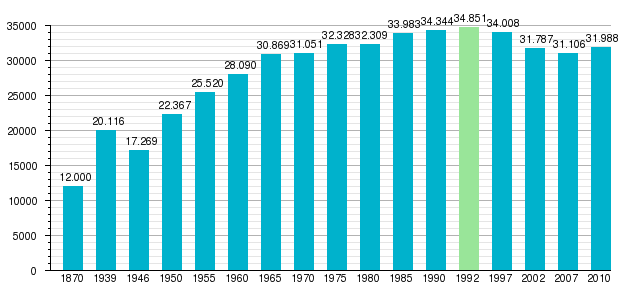Bielawa
| Bielawa | |||
|---|---|---|---|
 | |||
| |||
 Bielawa | |||
| Coordinates: 50°42′N 16°37′E / 50.700°N 16.617°E | |||
| Country |
| ||
| Voivodeship | Lower Silesian | ||
| County | Dzierżoniów | ||
| Gmina | Bielawa (urban gmina) | ||
| Established | 13th century | ||
| Town rights | 1924 | ||
| Government | |||
| • Mayor | Ryszard Dźwiniel | ||
| Area | |||
| • Total | 36.21 km2 (13.98 sq mi) | ||
| Highest elevation | 964 m (3,163 ft) | ||
| Lowest elevation | 280 m (920 ft) | ||
| Population (2010) | |||
| • Total | 31,988 | ||
| • Density | 880/km2 (2,300/sq mi) | ||
| Time zone | UTC+1 (CET) | ||
| • Summer (DST) | UTC+2 (CEST) | ||
| Postal code | 58-260 to 58-263 | ||
| Area code(s) | +48 74 | ||
| Car plates | DDZ | ||
| Website | http://www.bielawa.pl | ||
Bielawa [bʲɛˈlava] (![]()
Bielawa lies in the central part of Lower Silesia, along the Bielawica stream in the Sowie Mountains region. The town covers an area in excess of 36 square kilometres (14 sq mi).
Bielawa lies at an altitude range of 280 and 964 m above sea level, in the Sowie Mountains. It is considered one of the most naturally beautiful regions of the Lower Silesian Voivodeship, and is a year-round tourist destination. Its outdoor attractions include four major hiking trails of varying difficulty in an 80 square kilometer scenic park, as well as cycling trails and ski lifts.
History
- 13th century — Bielawa was established
- 1720 — First brick house
- 1741 — Addressing the village by the Prussian army
- 1805 — Christian Dierig involves weaving company (Christian Dierig AG)
- 1806-1808 — French occupation
- 1891 — Railway line Dzierżoniów - Bielawa opened
- 1924 — Bielawa given town rights
- 1945 — Soviet occupation
- 2006 — The opening of the bypass
Main sights
Bielawa has a rich choice of old architecture. At its center is the 19th-century Neo-Gothic Church of the Assumption with a 101 m tall tower, the third tallest in Poland. Other interesting buildings include a late-Renaissance palace originally built as a fortified manor house; the Church of the Corpus Christi, erected in 1743; and numerous 18th-century Baroque houses that were restored in the 19th and early 20th centuries. It is also a home to a number of medieval penitential crosses.
Population

Famous people

- Jeremiah Dencke (1725−1795), composer
- Ferdinand Gottlieb Flechtner (1811–1867), German industrialist
- Adolph Franz (1842–1916), German politician
- Friedrich Dierig (1845–1931), German industrialist
- Arthur Philipp Flechtner (1858–1936), Prussian General
- Karl Franz (1881–1967), German politician
- Georg Muschner (1885–1971), German cinematographer
- Walter Möse (1920–1944), Wehrmacht Oberfeldwebel
- Waltraut Engelberg (born 1929), author and wife of Ernst Engelberg
- Johann Alexander Wisniewsky (1929–2012), German industrialist
- Horst Weigang (born 1940), German athlete
- Eleni Tzoka, singer
- Aleksandra Kwasniewska, singer
- Robert Skibniewski, basketball player
- Marcin Teodoru, Hollywood Film Director http://www.circlefilms.com
- Tomasz Zabłocki, basketball player
- Jarosław Kuźniar, journalist in TVN24
- Janusz Góra, footballer
- Jacek Trzeciak, footballer
- Adam Wysota, one of the pioneers of free-spirit motorcycling on the American continent.
- Art Binkowski, Polish-Canadian Olympic boxer (Sydney, 2000)
International relations
Twin towns — Sister cities
Bielawa is twinned with:




Surroundings
- Gola Dzierżoniowska Castle
- Medieval town of Niemcza
- Cistercian monastery at Henryków
External links
- Official town website
- Jewish Community in Bielawa on Virtual Shtetl
| Wikimedia Commons has media related to Bielawa. |


